-

人教版新目标初中英语八年级下册Have you ever been to an amusement park教案
(1)Have you ever been to …? Yes, I have. / Yes, I have ever been to …No, I haven’t. / No, I have never been to …(2)When did you go there? I went there last year. (3)I have never been to a water park. Neither have I. I have ever been to an amusement park. So have I. (4)How long have you been studying English? I’ve been studying English since nine o’clock. I’ve been studying English since I came back home. I’ve been studying English for five hours. (5)What’s that? It’s an amusement park in Japan. I’ve never been to an amusement park like it before. It’s fun to learn another language. Let’s go tonight. Isn’t this great?space museum, amusement park, water park, South America, Peru, Holland, European culture, tour guide, flight attendant, musical instrument, more than, be from, get to, take lessons, neither, discover, graduate, change

人教版新目标初中英语八年级下册Would you mind turning down the music教案
Step 4. Group work (4)1. Ask a pair of students to read the dialogue. Say, This activity provides speaking, listening and writing practice using the target language.2. Ask students to complete the work in groups.3. Check the answers with the whole class. 4. Explain some of the language points. Step 5. Word review (Self check 1)1. Ask students to read the words and the phrases given. 2. Fill in the blanks with proper forms of these words to complete the sentences. 3. Check the answers with the whole class. Homework:Do activity 2 on page 57 after class. Period 6Teaching aims: 1. Teach vocabulary words and the useful expressions. 2. Enable the students to learn etiquette in different culture. 3. Help the students learn how to behave politely in public places and in daily life. Teaching procedures:Step 1. RevisionHelp students to review the function of making requests through a free talk. Then lead them to the topic of etiquette. Explain the meaning of etiquette. Or, ask students to look it up in the dictionary. Step 2. Pre-reading (Section 1)1. Ask students to read the picture and make a list with their partner about how many rules of etiquette can be seen being broken.

人教版新目标初中英语九年级上册I like music that I can dance to教案
教学目标: 1. Express preferences2. Talk about one’s likes and dislikes and the reasons3. Learn to express one’s opinions 4. Learn to write a reply 语言功能: 1) Talk about one’s preferences, using t he relative clause2) Talk about people’s likes and dislikes and the reasons3) Talk about opinions语言结构: Relative clauses with that and who语言目标:What kind of music do you like?I like music that I can sing along with.I love singers who write their own music.We prefer music that has great lyric.重点词汇及短语:heart, photography, interest, class, whatever, miss, okay, expect, sweet, taste, itself, laboratory, cancer, increase, biscuit, main, care, prefer… to…, remind somebody of …, dance to, sing along with, be sure to, interest somebody, make somebody adj., to be honest, suit somebody, on display, catch up教学重难点:What do other people think of the different kinds of things? How to express one’s opinions? 学习方式:讨论,合作学习情感目标:通过本单元的学习,能提高学生的艺术鉴赏能力和审美情趣,并引导学生养成健康的饮食习惯。课时安排5课时第一课时:Section A: 1a-2c第二课时:Section A : 3a-4第三课时:Section B:1-2c, Self check2第四课时:Section B: 3a-4, Self check1第五课时:Self check ReadingI like music that I can dance to.

人教版新目标初中英语九年级上册I used to be afraid of the dark教案
内容提示1.本单元主要内容是学会used to结构。Used to +动词原形表示过去经常、以前常常,只用于过去式中,用来表示现在已不存在的习惯或状态。例如:They used to play football together.他们过去常在一起蹋足球。(现在不在一起踢了)2.used to的疑问形式和否定形式为Did you use to…?和I didn’t use to… 也可以用Used you to…?和I used not to…但现在多使用前者。例如:Did you used to swim in the river? 你过去常在河里游泳吗?I didn’t use to play the piano. 我以前并不经常弹钢琴。教学目标一、学习目标(Language Goal) 1.学会陈述自己过去常做的事情。2.学会陈述自己过去的爱好等。3.能够表达自己现在和过去在外表、性格、娱乐等方面的变化。4.能够表达朋友、家人等现在和过去的变化。二、语言结构(Language Structures) 1.I used to be short when I was young. 我年轻时个子很矮。 2. —Did you use to have straight hair? 你过去是直发吗?—Yes, I did. 是的。 3. —Did you use to play the piano? 你过去弹钢琴吗?—No, I didn’t. 不,我不弹。 4.I used to be afraid of dark. 我过去害怕黑暗。 5.I’m terrified of the snakes. 我害怕蛇。

人教版新目标初中英语九年级下册By the time I got outside, the bus had already left教案
Ⅰ. Teaching Aims and Demands1. Knowledge Objects(1) Key Vocabularyoversleep(2) Target LanguageWhat happened?I overslept. And by the time I got up, my brother had already gotten in the shower.2. Ability Objects(1) Teach the students to use the new words.(2) Train the students to narrate past events with the Past Perfect Tense.(3) Train the students' listening and speaking skills with the target language.3. Moral ObjectIt’s a good habit to go to bed early in the evening and get up early in the morning. So you’ll never be in a hurry in the morning.Ⅱ. Teaching Key Points1. Key Vocabularyoversleep2. Target LanguageNarrate past events with the Past Perfect TenseⅢ. Teaching Difficult Points1. Train the students to narrate past events with the Past Perfect Tense.2. Train the students to understand the target language in spoken conversation.Ⅳ. Teaching Methods1. Thinking of examples from the students' real lives.2. Making sentences by looking at the pictures.Ⅴ. Teaching AidA tape recorderⅥ. Teaching ProceduresStep I Revision1. Revise the language points in Unit 8.Ask some questions like this: What volunteer work would you like to do?Help the students to answer, I’d like to…/I love to…/I hope to2. Practice the dialogue in Activity 3c on page 62 again. Get students to role play the similar dialogues with the following.

人教版新目标初中英语九年级上册It must belong to Carla教案
一、Section A该部分有4个模块。第一模块围绕Whose volleyball is this? 这一话题展开思维( 1a)、听力(1b)、口语( 1c)训练;第二模块围绕上一模块中的话题进行听力( 2a-2b)、口语训练( 2c);第三模块继续围绕前两个模块中的“making inferences”展开训练。训练形式为阅读排序( 3a)和两人问答(3b);第四模块仍就上一话题展开讨论。二、Section B该部分有4个模块。第一模块要求根据图画和所提供的单词写出合理的句子;第二模块在听力( 2a-2b)和分角色口语训练( 2c)的基础上,继续进行“推测”训练; 第三模块围绕“Strange events in Bell Tower neighborhood”这一话题展开阅读( 3a)和写作(3b -3c)训练;第四模块以dream为话题展开小组活动。三、Self Check该部分有3个模块。第一模块以填空形式对所学词汇进行训练;第二模块就8个谚语展开阅读和讨论。

人教版新目标初中英语九年级下册Rainy days make me sad教案
1. 教材分析本单元以how do things affect you?为话题, 从颜色、天气、音乐、广告、产品等方面谈论了外界事物如何影响人的心情。要求学生掌握表达某物或某事给人带来的感觉、看法或影响等。共设计了四个部分的内容:Section A 该部分有4个模块:第一模块围绕Which restaurant would you like to go to?这一话题展开思维(1a)、听力(1b)、口语(1c)训练;第二模块围绕How does music affect you? 进行听力(2a-2b)、口语训练(2c);第三模块继续围绕how do colors in the restaurant affect you这一话题展开训练,训练形式为阅读和问题体验(3a)和小组活动(3b);第四模块仍就How do things affect you这一话题以调查的形式展开讨论。Section B该部分有4个模块:第一模块围绕产品广告对人们的影响这一话题以“配对”(1a)与“列举”(1b)两种形式展开训练;第二模块继续围绕How do things affect you? 进行听力(2a-2b)、口语对话训练(2c);第三模块围绕“Advertising”这一话题展开阅读(3a-3b)和写作(3c)训练;第四模块围绕How posters affect you这一话题以口语训练形式展开小组活动。

人教版新目标初中英语九年级下册Could you please tell me where the restrooms are教案
Step Ⅰ RevisionCheck homework. Ask a few students to read the article in 3a.Then ask a few students to read their guides.Step Ⅱ Part 1Look at the words in the box. Ask a student to read them. Make sure the students understand the meaning of the words. You are to fill in the blanks with the words. In some cases, students may need to use another form of the word, for example adjusting for tense or subject/ verb agreement.Ask students to fill in the blanks on their own.Check the answers. Step ⅢPart 2Go through the instructions with the class.Look at the example with the students.Ask students what the answer would be.Ask a student to read the question and answer it.Excuse me, could you tell me where the bank is, please?The bank is across the street from the shopping malt.Get students to complete the work in pairs.Check the answers. Ask a few students to read their questions.Step Ⅳ Just for Fun!Ask all the students to read the conversation. Ask: What is funny about this cartoon? Help students to explain. A Martian is a person from the planet Mars.There is no such thing as Martian food on Earth, and the clerk looks silly because he is trying to think of where there is a Martian restaurant.Invite some pairs of students to present this conversation to the rest of the class.Step Ⅴ Summary and HomeworkIn this class, we’ve done much writing practice using the key vocabulary words and the target language presented in this unit. After class, please finish the questions in 2 in your exercise books. Then finish the exercises on pages 47~48 of the workbook as well.The Seventh Period Ⅰ Teaching Aims and Demands1. Knowledge Objects(1) Key Vocabularyimage, adventure, jealousy, hero, crime, journey, brave, no longer, show interest in, take it easy, become interested in, plain looks(2)Text:Grown-ups like cartoons, too.2. Ability Objects(1) Fast-reading to get a general idea of the text.(2) Careful-reading to get the detailed information in the text.

人教版新目标初中英语九年级下册I’ll help clean up the city parks教案
Talk about offering help (P60)I’ll help clean up the city parks.A: I’d like to work ...B: You could help ...Talk about ways to tell people about the Clean-Up Day (P61)We need to ...We can’t ...I’ll ...Talk about the work the volunteers do (P62)These three students all volunteer their time to help other people.Somebody loves to ... / helps ... / plans to ... / wants to ...A: What do you like doing?B: I like ... A: What kind of volunteer work do you think I could do?B: You could ...1. 重点词汇advertisement, fix, repair, pleasure, blind, deaf, shut, carry, specially, fetch2. 认读词汇hunger, homeless, cheer, clean-up, sign, establish, major, commitment, elementary, veterinarian, coach, similar, call-in, strategy, disabled, organization, unable, support, appreciate, donation, part of speech, pronoun, adverb, preposition, conjunction, donate, Jimmy, Sally3. 词组clean up, cheer up, give out, put off, set up, think up, take after, fix up, give away, put up, hand out, work out, at once

人教版新目标初中英语九年级下册You’re supposed to shake hands教案
教学目标:1. 掌握本单元一些重点词汇的写法和用法。2. 学会自如谈论餐桌礼仪。Step 1 RevisionAsk some students to retell the customs at the table in France in the passage in 3a.Step 2 Self checkPart 1. Fill in each bland with the correct word given. Students do the exercises by themselves at first. Then check the answers. Ask the students to comprehend the sentences and help them point out uses of some words, like “arrive (at / in) sw., spend time / money on sth , spend time / money (in) doing sth.”Part 2. Read about Fan Ling’s experience in a western restaurant. Understand the passage. Point out some key points in the passage.1. be / get used to doing sth. 习惯做某事2. begin with = start with 以….开头3. crowd v. 挤满,塞满 the crowd 人群 crowded adj. 拥挤的Then students discuss about how she would solve her problem. Ask some to share their stories with others.Part 3. Complete the crossword by looking at the sentences on the left. Then check the answers.

人教版新目标初中英语七年级下册I ’d like some noodles教案
教学过程Step 1: warming-up Sing a song---------“food and drink” Step 2: Revision1 Dictation2 Revise: What kind of noodles would you like?I’d like …What size bowl of noodles would you like?I’d like…Step 3: Presentation1 show pictures of food, ask students say the words.2 Students read the newspaper ad in 3a. Fill in blanks with words in the box. Then read the ad together, the teacher explains some difficult language points.3 Check the answers Step 4 PracticeAsk students to finish 3b in the same way according to 3a. Students read the short passage and fill in the blanks .At last, check the answers.Step 5 productionAsk students to write their own ad for dumplings, noodles, drinks, and other foods they know. Then ask students to read their partner’s ad. Then order food and drink from their partner.Step 6 Home workGroup work – make an ad about “food and drink”
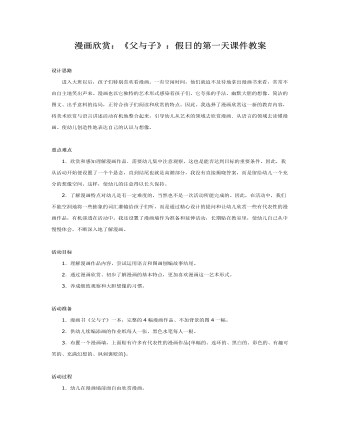
漫画欣赏:《父与子》:假日的第一天课件教案
重点难点1.欣赏和感知理解漫画作品.需要幼儿集中注意观察,这也是能否达到目标的重要条件。因此,我从活动开始便设置了一个个悬念,直到结尾也就是高潮部分,我没有直接揭晓答案,而是留给幼儿一个充分的想像空间。这样,使幼儿的注意得以长久保持。2.了解漫画特点对幼儿是有一定难度的,当然也不是一次活动所能完成的。因此,在活动中,我们不能空洞地将一些抽象的词汇灌输给孩子们听,而是通过精心设计的提问和让幼儿欣赏一些有代表性的漫画作品,有机渗透在活动中。我还设置了漫画墙作为准备和延伸活动,长期贴在教室里,使幼儿自己从中慢慢体会,不断深入地了解漫画。 活动目标1.理解漫画作品内容,尝试运用语言和图画刨编故事结尾。2.通过漫画欣赏、初步了解漫画的基本特点,更加喜欢漫画这一艺术形式。3.养成细致观察和大胆想像的习惯。 活动准备1.漫画书《父与子》一本,完整的4幅漫画作品、不加背景的图4一幅。2.供幼儿续编添画的作业纸每人一张、黑色水笔每人一根。3.布置一个漫画墙,上面贴有许多有代表性的漫画作品(单幅的、连环的、黑白的、彩色的、有趣可笑的、充满幻想的、讽刺褒贬的)。
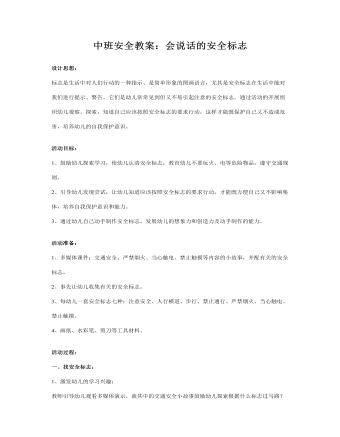
中班安全教案:会说话的安全标志
活动目标: 1、鼓励幼儿探索学习,使幼儿认清安全标志,教育幼儿不要玩火、电等危险物品,遵守交通规则。 2、引导幼儿发现尝试,让幼儿知道应该按照安全标志的要求行动,才能既方便自己又不影响集体,培养自我保护意识和能力。 3、通过幼儿自己动手制作安全标志,发展幼儿的想象力和创造力及动手制作的能力。 活动准备: 1、多媒体课件:交通安全、严禁烟火、当心触电、禁止触摸等内容的小故事,并配有关的安全标志。 2、事先让幼儿收集有关的安全标志。 3、每幼儿一套安全标志七种:注意安全、人行横道、步行、禁止通行、严禁烟火、当心触电、禁止触摸。 4、画纸、水彩笔、剪刀等工具材料。
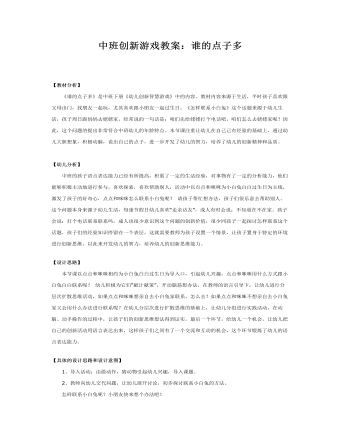
中班创新游戏教案:谁的点子多
【幼儿分析】 中班的孩子语言表达能力已经有所提高,积累了一定的生活经验,对事物有了一定的分析能力,他们能够积极主动地进行参与,喜欢探索,喜欢帮助别人,活动中以点点和咪咪为小白兔白白过生日为主线,激发了孩子的好奇心,点点和咪咪怎么联系小白兔呢?请孩子帮忙想办法,孩子们很乐意去帮助别人。这个问题本身来源于幼儿生活,每逢节假日幼儿喜欢“走亲访友”,成人有时会说:不知道在不在家。孩子会说:打个电话联系联系吗。成人也很少意识到这个问题的创新价值,很少同孩子一起探讨怎样联系这个话题,孩子们的经验知识停留在一个表层,这就需要教师为孩子设置一个情景,让孩子置身于特定的环境进行创新思维,以此来开发幼儿的智力,培养幼儿的创新思维能力。【设计思路】 本节课以点点和咪咪相约为小白兔白白过生日为导入口,引起幼儿兴趣,点点和咪咪用什么方式跟小白兔白白联系呢?幼儿积极为它们“献计献策”,开动脑筋想办法,在教师的语言引导下,让幼儿进行分层次扩散思维活动,如果点点和咪咪想亲自去小白兔家联系,怎么去?如果点点和咪咪不想亲自去小白兔家又会用什么办法进行联系呢?在幼儿分层次进行扩散思维的基础上,让幼儿分组进行实践活动,在动脑、动手操作的过程中,让孩子们的创新思维想法得到证实。最后一个环节,给幼儿一个机会,让幼儿把自己的创新活动用语言表达出来,这样孩子们之间有了一个交流和互动的机会,这个环节锻炼了幼儿的语言表达能力。
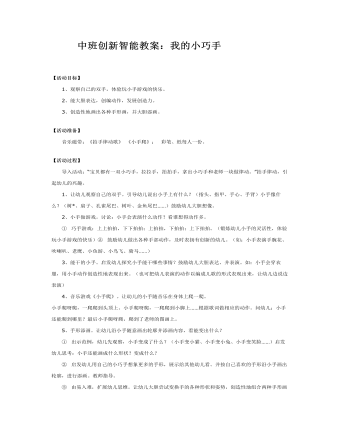
中班创新智能教案:我的小巧手
2、能大胆表达,创编动作,发展创造力。3、创造性地画出各种手形画,并大胆添画。【活动准备】 音乐磁带:《拍手律动歌》《小手爬》; 彩笔、纸每人一份。【活动过程】 导入活动:“宝贝都有一双小巧手,拉拉手,拍拍手,拿出小巧手和老师一块做律动。”拍手律动,引起幼儿的兴趣。1、让幼儿观察自己的双手。引导幼儿说出小手上有什么?(指头、指甲、手心、手背)小手像什么?(树*、扇子、孔雀尾巴、树叶、金鱼尾巴……)鼓励幼儿大胆想像。2、小手做游戏。讨论:小手会表演什么动作?看谁想得动作多。① 巧手游戏:上上拍拍,下下拍拍;上拍拍,下拍拍;上下拍拍。(锻炼幼儿小手的灵活性,体验玩小手游戏的快乐)② 鼓励幼儿做出各种手部动作,及时表扬有创新的幼儿。(如:小手表演手腕花、吹喇叭、老鹰、小鱼游、小鸟飞、骑马……)3、能干的小手。启发幼儿探究小手能干哪些事情?鼓励幼儿大胆表达、并表演。如:小手会穿衣服,用小手动作创造性地表现出来。(也可把幼儿表演的动作以编成儿歌的形式表现出来,让幼儿边说边表演)
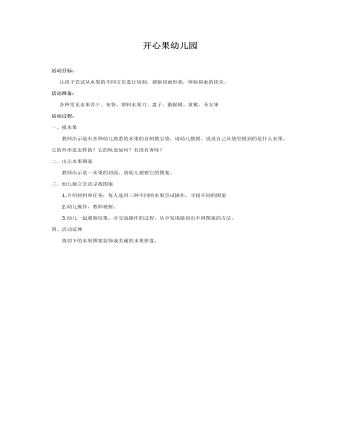
中班科学:水果里的图案课件教案
活动准备: 各种常见水果若干、布袋、塑料水果刀、盘子、猕猴桃、黄桃、圣女果活动过程:一、摸水果 教师出示装有各种幼儿熟悉的水果的自制摸宝袋,请幼儿摸摸、说说自己从袋里摸到的是什么水果,它的外形是怎样的?它的味道如何?有没有香味?二、出示水果图案 教师出示某一水果的切面,请幼儿观察它的图案。
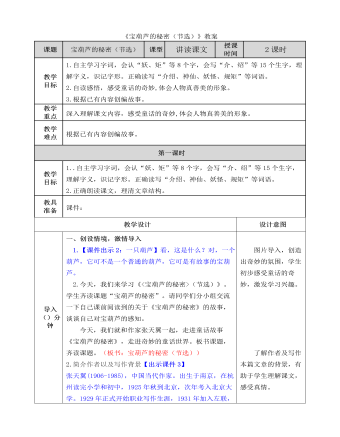
部编人教版四年级下册《 宝葫芦的秘密(节选)》教案
一、创设情境,激情导入1.【课件出示2:一只葫芦】看,这是什么?对,一个葫芦,它可不是一个普通的葫芦,它可是有故事的宝葫芦。2.今天,我们来学习《(节选)》。学生齐读课题“宝葫芦的秘密”。请同学们分小组交流一下自己课前阅读到的关于《宝葫芦的秘密》的故事,谈谈自己对宝葫芦的感知。今天,我们就和作家张天翼一起,走进童话故事《宝葫芦的秘密》,走进奇妙的童话世界。板书课题,齐读课题。(板书:宝葫芦的秘密(节选))2.简介作者以及写作背景【出示课件3】
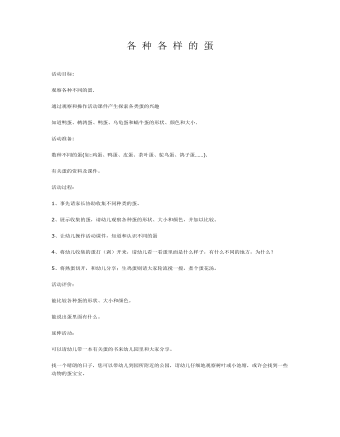
中班科学课件教案:各种各样的蛋
通过观察和操作活动课件产生探索各类蛋的兴趣 知道鸭蛋、鹌鹑蛋、鸭蛋、乌龟蛋和蜗牛蛋的形状、颜色和大小. 活动准备: 数种不同的蛋(如:鸡蛋、鸭蛋、皮蛋、茶叶蛋、鸵鸟蛋、鸽子蛋……).有关蛋的资料及课件。 活动过程: 1、事先请家长协助收集不同种类的蛋。 2、展示收集的蛋,请幼儿观察各种蛋的形状、大小和颜色,并加以比较。 3、让幼儿操作活动课件,知道和认识不同的蛋 4、将幼儿收集的蛋打(剥)开来,请幼儿看一看蛋里面是什么样子,有什么不同的地方,为什么? 5、将熟蛋切开,和幼儿分享;生鸡蛋则请大家轮流搅一搅,煮个蛋花汤。 活动评价: 能比较各种蛋的形状、大小和颜色。 能说出蛋里面有什么。 延伸活动: 可以请幼儿带一本有关蛋的书来幼儿园里和大家分享。 找一个晴朗的日子,您可以带幼儿到园所附近的公园,请幼儿仔细地观察树叶或小池塘,或许会找到一些动物的蛋宝宝。
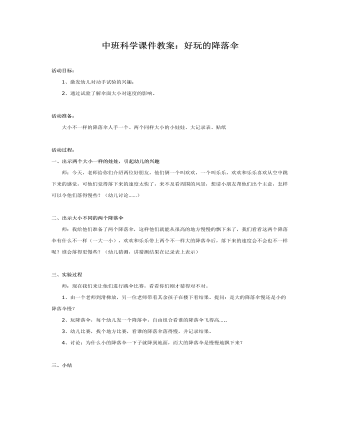
中班科学课件教案:好玩的降落伞
2、通过试验了解伞面大小对速度的影响。 活动准备: 大小不一样的降落伞人手一个、两个同样大小的小娃娃、大记录表、贴纸 活动过程:一、出示两个大小一样的娃娃,引起幼儿的兴趣 师:今天,老师给你们介绍两位好朋友,他们俩一个叫欢欢,一个叫乐乐,欢欢和乐乐喜欢从空中跳下来的感觉,可他们觉得落下来的速度太快了,来不及看周围的风景,想请小朋友帮他们出个主意,怎样可以令他们落得慢些?(幼儿讨论……)
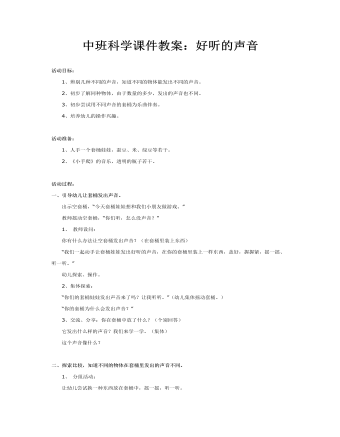
中班科学课件教案:好听的声音
2、初步了解同种物体,由于数量的多少,发出的声音也不同。3、初步尝试用不同声音的套桶为乐曲伴奏。4、培养幼儿的操作兴趣。 活动准备:1、人手一个套桶娃娃,蚕豆、米、绿豆等若干。2、《小手爬》的音乐,透明的瓶子若干。 活动过程:一、引导幼儿让套桶发出声音。 出示空套桶,“今天套桶娃娃想和我们小朋友做游戏。” 教师摇动空套桶,“你们听,怎么没声音?”1、教师设问: 你有什么办法让空套桶发出声音?(在套桶里装上东西)“我们一起动手让套桶娃娃发出好听的声音,在你的套桶里装上一样东西,盖好,握握紧,摇一摇、听一听。” 幼儿探索、操作。